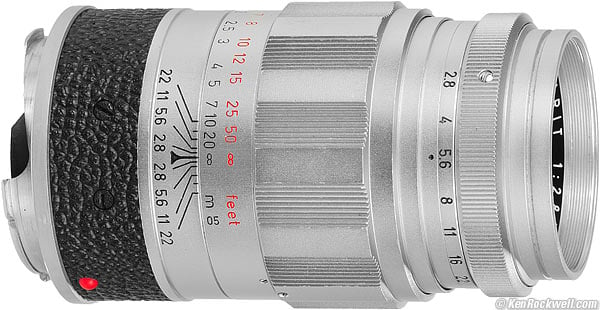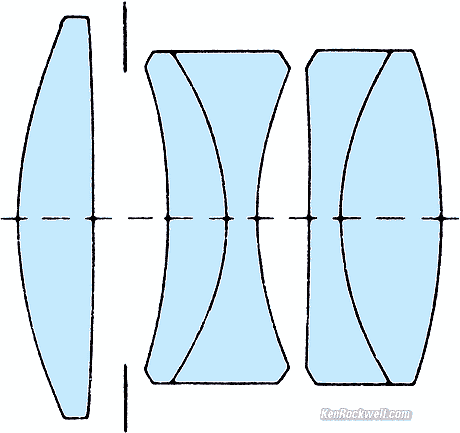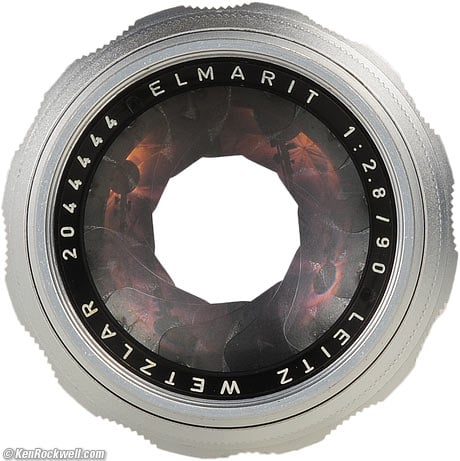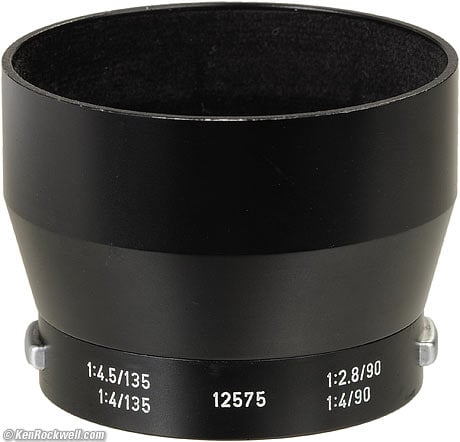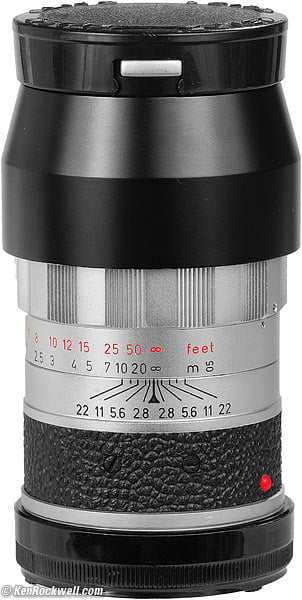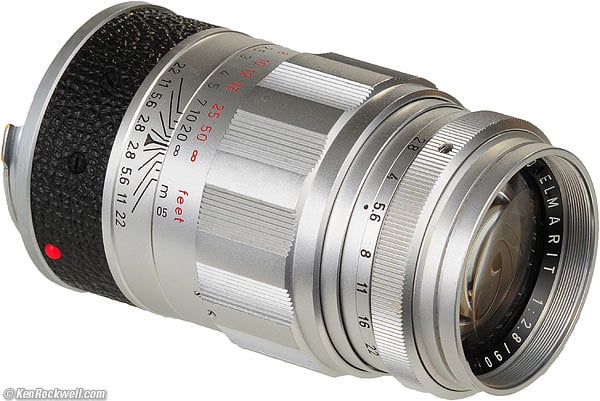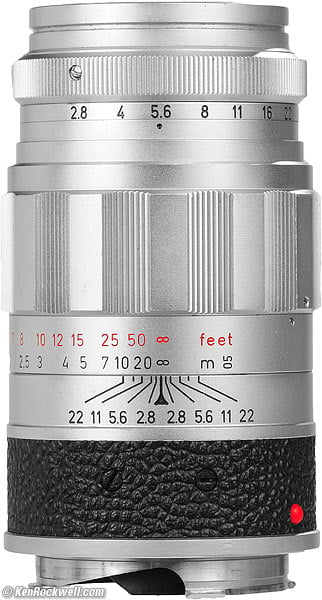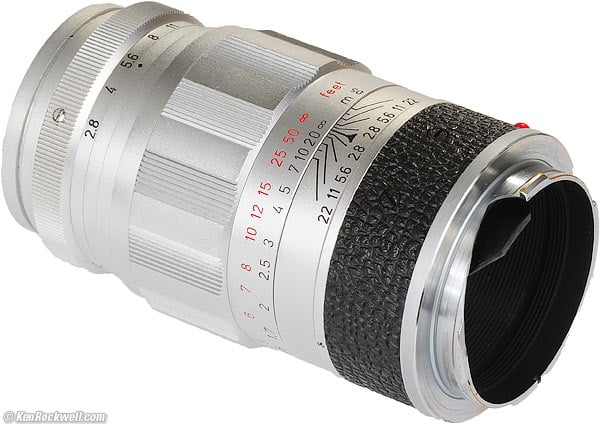Home Donate New Search Gallery How-To Books Links Workshops About Contact
LEICA 90mm f/2.8
ELMARIT
(1958-1974)
© 2010 KenRockwell.com. All rights reserved.
Intro Specs Performance Compared Recommendations
LEICA ELMARIT 90mm f/2.8 (39mm filters, 11.7 oz/332g, about $500 used). Vergrößern. You can get them at this link to them at eBay; you also can get them from Adorama and OC Camera. It helps me keep reviewing these oldies when you get yours through these, links, thanks! Ken.
February 2010 Leica Camera Reviews Leica Lens Reviews
Sample Images: Yosemite in Winter February 2011.
Leica 90mm f/2.8 Lenses Compared
Leica 90mm f/2 Lenses Compared
Introduction top
Intro Specs Performance Compared Recommendations
|
I personally buy from Adorama, Amazon, Ritz, B&H, Calumet and J&R. I can't vouch for ads below.
|
This LEICA ELMARIT 90mm f/2.8 was Leica's most popular long lens of the 1960s.
It works flawlessly on every LEICA M, from 1954's LEICA M3 to today's LEICA M7, LEICA MP and LEICA M9.
Its performance is excellent for any sort of photography, however if you're more of a pixel-counter than a photographer, the newer LEICA ELMARIT-M 90mm f/2.8 has superior optics in a larger package. This ELMARIT is also very prone to flare reflected from its long, empty internal barrel, so be careful.
This 90mm f/2.8 ELMARIT was praised by Leica at its introduction as being one stop faster with only 1 ounce more weight than the existing LEICA ELMAR 90mm f/4.
It came in silber chrom in the 1960s as shown, and later in black in the 1970s.
This ELMARIT was sold alongside the 90mm f/4 ELMAR as well as the much less popular LEICA 90mm f/2 SUMMICRON. Today in 2010, even though Leica sold ten times as many of these f/2.8 ELMARIT as they did f/2 SUMMICRON, you'll see tens times as many SUMMICRON for sale, for less money than these f/2.8 ELMARIT.
Today it sells for about $500 used. Its catalog price in 1969 was $1,175, corrected for inflation in 2010 ($198 in 1969 dollars).
For more history and comparisons, see Leica 90mm f/2.8 Lenses Compared and comparisons among other Leica 90mm f/2 lenses.
Specifications top
Intro Specs Performance Compared Recommendations
Name
Leica calls this the LEICA ELMARIT 90mm f/2.8.
Optics top
Cross-section. Vergrößern.
5 elements in 3 groups. Triplet variant.
Single-coated in magenta.
Diaphragm
LEICA ELMARIT 90mm f/2.8 at f/5.6. Vergrößern.
12 blades.
Stops down to f/22.
Full-stop clicks, Newer versions may have half-stop clicks; I've not seen one.
There are two sets of aperture scales, each 180º from the other.
The diaphragm has straight edges at f/4, f/5.6, f/11 and f/16.
It has inwardly-curved edges at f/8, and between f/16 and f/22.
It is perfectly round at f/22.
Close Focus
1 meter (3' 4" or 40").
Size top
51.9mm diameter, maximum (focus ring).
87.00mm (3.425") extension from flange, 93.66mm (3.685") overall.
Filters
39 x 0.5mm screw-in filters (E39).
Attachments
A42 (42mm outside diameter).
Weight top
Lens only (1960 sample): 11.742 oz (332.9g).
Lens with brass front cap: 12.180 oz. (345.3g).
Lens with modern rear and contemporary brass front cap: 12.580 oz. (356.7g).
Another sample from 1964 measured 11.705 oz. (331.9g).
Rated: 11.7 oz. (330g).
Hood top
LEICA 12 575 hood. Vergrößern.
The hood snaps on. This is the newer version; the older version was marked for 9 cm and 13.5 cm lenses and has a chrome ring. They do the same thing.
It is not particularly effective. It lets in plenty of light that's not in the the image, and then bounces off the internal lens tube and causes flare.
Caps top
With the exception of the special 14 033 cap to cover the reversed hood as shown, today's standard 39mm front and M rear caps all work perfectly.
LEICA ELMARIT 90mm f/2.8. Vergrößern.
Front cap
For front of lens: 14 122 (A42). Today's replacement is the snap-on plastic 14 038.
To fit over reversed 12 575 hood: 14 033.
Rear cap
14 051.
Today's standard 14 269 cap works great.
Part Numbers top
Bayonet: 11 129 (ELRIM).
Screwmount: 11 029 (ELRIT).
Lens head only for Visoflex II or III: 11 026. (use universal focus mount 16 464 for focus from infinity to 0.5 meters.)
Cap for front of lens (no hood): 14 122.
Hood: 12 575 (included; previously IUFOO).
Cap to fit over reversed 12 575 hood: 14 033.
Rear Cap: 14 051. (Today's standard 14 269 cap works great.)
Polarizing filter: 13 352.
Case, for lens with reversed hood: 98 292.
90mm finder: SGVOO.
Quality top
Made in Germany.
LEICA ELMARIT 90mm f/2.8. Vergrößern.
Performance top
Intro Specs Performance Compared Recommendations
This classic 90mm f/2.8 lens has more than enough performance to make great images in the hands of the seasoned photographer.
If you prefer to count pixels, it has inferior performance to newer lenses. It is less sharp and has more flare.
Its weakest point it its flare, caused by a combination of the huge field-of-view from its simple design, compounded by the long tube in which it is mounted. Light from areas far away from the active image gets in, and then bounces off the interior of the long empty tube between the rear element and the mount. The 12575 hood is not effective; it lets in too much stray light.
Leica says this ELMARIT gives optimum brilliance at f/4, and to stop it down at close distances for optimum depth-of-field.
Bokeh top
Bokeh, the quality of out-of-focus areas as opposed to the degree of defocus, is mediocre.
f/2.8: Somewhat busy; blur circle edges are slightly enhanced.
f/4 - f/8: neutral; completely round, too.
Here are crops from extremely enlarged prints of about 36 x 48" (100 x 150cm), or the equivalent of looking at LEICA M9 images at 100% on-screen.
In these examples, a vertically polarized phase lattice was set up at 3 meters (10 feet) on which the ELMARIT was focused, and the synthetic reference vegetation seen out of focus in the background was at 15 meters (50 feet).
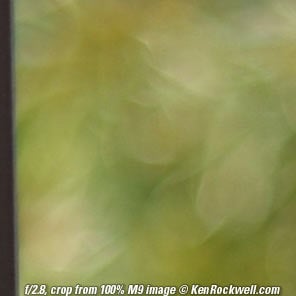 |
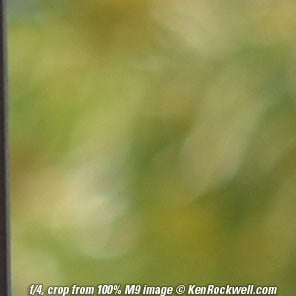 |
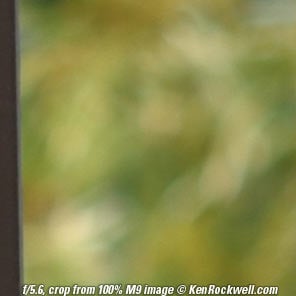 |
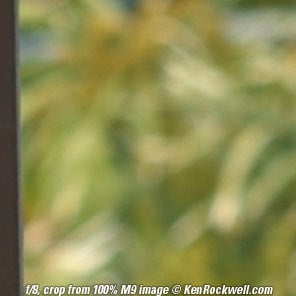 |
Diaphragm Calibration top
The calibration is perfect.
The meter in my M9 tracks each full-stop click perfectly.
Distortion top
The LEICA ELMARIT 90mm f/2.8 has no distortion.
Shoot it on the M9 at any reasonable distance, blow it up to 200% on-screen, drop a ruler on it in Photoshop, and it's still perfectly straight within a pixel or two.
This is better than the newer LEICA 90mm f/2.8 TELE-ELMARIT-M (1974-1990), which has some pincushion distortion. The newest LEICA 90mm f/2.8 ELMARIT-M (1990-2008) also has no distortion
Ergonomics top
LEICA ELMARIT 90mm f/2.8. Vergrößern.
The LEICA ELMARIT 90mm f/2.8 handles great.
It's easy to focus and to adjust the aperture, with or without the hood attached.
Focus is just right: it turns from infinity to 1 meter in 180º.
There are two sets of aperture scales, each 180º from the other.
Finder Blockage top
There is no blockage without the hood.
With the 12 575 hood, there is minor to moderate blockage, depending on focused distance.
Focus top
Focus accuracy is a personal issue between your sample of body and your sample of lens.
If you're picky, it's very rare to find any combination of samples of rangefinder camera and long lens that give perfect results at every distance, every time.
Sorry. It's not the lens: it's you and your particular samples.
This said, after I had this lens serviced by Gus Lazzari, it focuses more accurately than most other 90mm lenses.
Falloff (darker corners) top
The LEICA 90mm f/2.8 ELMARIT has no visible falloff. This is much better than the 90mm f/4 ELMAR-C, for example.
I've greatly emphasized it below by shooting a gray field and presenting it against another gray field
LEICA ELMARIT 90mm f/2.8 falloff on full-frame M9 at infinity,
© 2010 KenRockwell.com. All rights reserved.
|
Flare and Ghosts top
The LEICA 90mm ELMARIT has a load of flare.
The simple lens sees a huge angle, so much that half of the world shines in and lights up the sides of the long, empty optical tube. There is a lot of empty space behind the elements, and it all gets lit up from light outside the picture area.
The light bounces off the tube, and onto your image.
The 12 575 hood doesn't help. It doesn't cut off any of the light that leads to flare, although it may help reduce ghosts.
Ghosts aren't likely a problem. This is a very simple design.
Lateral Color Fringes top
There no color fringes anywhere, either on film or on a LEICA M9.
Materials and Construction top
Like all LEICA lenses, this ELMARIT is made of are solid metal. The only plastic is the red mounting index ball.
To save weight, much of the outer barrel and control rings are made of anodized aluminum, with brass for the helicoids and most of the internals.All the marking are engraved and filled with paint.
Sharpness top
The more you know about photography, the more you know that lens sharpness doesn't matter.
If you're silly enough to think that lens sharpness affects picture sharpness, use the newest LEICA ELMARIT-M 90mm f/2.8 or the LEICA APO-SUMMICRON 90mm f/2 ASPH instead. This classic lens isn't as sharp.
If you worry about it, this lens is optimum at f/11.
As shot on the LEICA M9
f/2.8
Softer all over.
The center is slightly lower contrast with low resolution, and the sides and corners are much softer.
This said, it's still sharp enough to excite aliasing on an M9 at f/2.8 if you've got a fine repeating pattern!
f/4
Everything is much sharper and contrastier at f/4, especially the sides.
f/5.6
The center is optimum by f/5.6.
The sides are still softer.
f/8
The center is still optimum at f/8.
The sides are better than at f/5.6.
f/11
The center is still as sharp as f/8.
The sides are optimum at f/11.
f/16
Diffraction softens everything.
As shot on Fuji Velvia 50
It's a little less contrasty and relatively ho-hum at f/2.8. It's great at f/4 and fantastic by 5.6.
Rear, LEICA ELMARIT 90mm f/2.8. Vergrößern.
Compared top
Intro Specs Performance Compared Recommendations
This ELMARIT has much more flare, caused by light bouncing off the insides of the optical tube, than any of these other lenses. It usually will have lower contrast.
Specification Tables
Leica 90mm f/2.8 Lenses Compared
Leica 90mm f/2 Lenses Compared
Compared to new lenses
As covered above, any of the newest LEICA ELMARIT-M 90mm f/2.8, LEICA SUMMARIT-M 90mm f/2.5 or LEICA APO-SUMMICRON 90mm f/2 ASPH are far superior optically.
This probably won't be visible on film, but it will be obvious if you count the pixels from an M9.
These comparisons are as made on an M9:
Compared to the 90mm f/2 SUMMICRON (1958-1980)
The original LEICA 90mm f/2 SUMMICRON came out around the same time. It is a stop faster, twice as heavy, and cost 33% more. Leica only sold one-tenth as many of the big SUMMICRONS as it sold of this ELMARIT.
Today, the big SUMMICRON sells for less than this f/2.8 ELMARIT.
At f/2.8, this ELMARIT about as sharp in the center as the f/2 SUMMICRON, and this ELMARIT is sharper in the corners than the SUMMICRON.
At f/4 and smaller, they are about the same.
Neither has any distortion.
They use different filters and front caps. The SUMMICRON has a built-in hood.
Compared to the TELE-ELMARIT-M (1974-1990)
Compared to the newer LEICA 90mm f/2.8 TELE-ELMARIT-M, the TELE-ELMARIT-M is much sharper at f/2.8 in the center where it counts, while this older ELMARIT is sharper in the far corners, where it usually doesn't matter.
At f/4, they are about as sharp on the sides, while the TELE-ELMARIT-M is still much sharper in the center.
At f/5.6, the TELE-ELMARIT-M is now sharper all over than this older ELMARIT.
By f/8, they are pretty much the same.
The TELE-ELMARIT-M weighs much less, but has a small amount of pincushion distortion, while this ELMARIT has no distortion.
These use the same hoods, caps and filters.
Compared to the 90mm f/4 ELMAR (1933-1964)
The ancient LEICA 90mm f/4 ELMAR, came in screw, bayonet and collapsible bayonet mounts, all of which work on all current M cameras with an adapter if needed. These sell for $100 or less.
This f/2.8 ELMARIT is much sharper at f/4 in the center where it counts, and is much, much sharper in the corners than the old f/4 ELMAR at f/4.
At f/5.6, this ELMARIT is about as sharp in the center, and much sharper on the sides than the f/4 ELMAR.
By f/8 and f/11, they are all the same in the center, while this ELMARIT is still much sharper in the corners. It could just be sample variation, but the collapsible ELMAR was almost as good in the corners as this ELMARIT, while the screw-mount versions I compared were still much worse.
The collapsible bayonet-mount f/4 ELMAR weighs the same as this f/2.8 ELMARIT (332g vs. 337g), while the screw-mount ELMARs are tiny. None of these lenses has any distortion.
The bayonet-mount ELMARs use the same hoods and caps. The screw-mount lenses use A36 caps and filters.
Compared to the 90mm f/4 ELMAR-C (1973-1978)
The inexpensive LEICA 90mm f/4 ELMAR-C is a bargain, also selling for about $100.
The 90mm ELMAR-C has a slightly shorter actual focal length than this ELMARIT.
At f/4, they are about as sharp as each other.
At f/5.6, this ELMARIT is a little sharper than the ELMAR-C.
At f/8 and f/11, this ELMARIT is sharper than the ELMAR-C.
At f/16, diffraction makes them about the same.
The f/4 ELMAR-C has some lateral color fringes, but weighs much less (247g vs. 332g).
The f/4 ELMAR-C uses unique series 5.5 or 39x0.75mm filters, unique caps and unique hoods, none of of which are compatible with any other LEICA lenses.
Recommendations top
Intro Specs Performance Compared Recommendations
I'd suggest this ELMARIT for use with classic cameras like the LEICA M3, for when you're in the mood to shoot equipment from the 1960s. The LEICA 90mm f/2 SUMMICRON of the same era has about the same performance.
This classic LEICA ELMARIT 90mm f/2.8 is a solid enough performer, especially for film, but it is not easy to find used, and when you do, has often taken a beating and needs an overhaul.
It was always very popular, and people who have them aren't putting them up on eBay all the time. You'll see a ton of NOCTILUX for sale used because no one wants a NOCTILUX after they buy it and try it once, while this ELMARIT has enduring virtues and is very useful for any kind of photography.
Because of this, this ELMARIT sells used for about $500, and for $500, there are better lenses to get.
For a little less money, you can get the mostly superior LEICA 90mm f/2.8 TELE-ELMARIT-M, one of my favorites.
As a new purchase for a newer camera, or for use on digital cameras where you're looking at each pixel, for not much more money you can get the optically spectacular LEICA ELMARIT-M 90mm f/2.8.
Watch for flare. Be sure to shield bright skies with a card or your hand, because even with the 12 575 hood there are often visible flare blobs.
Deployment top
For use with color transparency film outdoors, I prefer a 39mm B+W 81A filter.
For B&W outdoors, you want a yellow filter standard, like the B+W 39mm #022, or a B+W 39mm orange filter for more contrast, especially in the skies.
For color print film or digital, you want a Leica 39mm silver-ring UV filter for protection, or go commando.
(the old M8 needed a Leica 39mm silver-ring IR filter.)
These old ELMARITs are usually so old and so worn today that you'll probably need to send yours in for service.
I use Leica specialist Gus Lazzari, who serviced this lens for me so I could review it. He took a lens that was quite beat up, and got it working perfectly again.
Acknowledgements
Many thanks to OC Camera and Gus Lazzari for their help with getting me access to the lenses I needed to complete this review and my comparisons.
Help me help you top
I support my growing family through this website, as crazy as it might seem.
If you find this as helpful as a book you might have had to buy or a workshop you may have had to take, feel free to help me continue helping everyone.
If you've gotten your gear through one of my links or helped otherwise, you're family. It's great people like you who allow me to keep adding to this site full-time. Thanks!
If you haven't helped yet, please do, and consider helping me with a gift of $5.00.
The biggest help is when you use any of these links when you get anything. It costs you nothing, and is this site's, and thus my family's, biggest source of support. These places always have the best prices and service, which is why I've used them since before this website existed. I recommend them all personally.
Thanks for reading!
Ken
Home Donate New Search Gallery How-To Books Links Workshops About Contact

